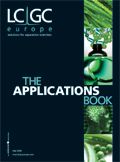New Generation of GC/High Resolution TOF-MS: APCI/APLI Source for Increased Flexibility
The Application Notebook
A new APCI/APLI source enables a high resolution TOF-MS to be coupled on LC and GC, thus increasing flexibility and performance of TOF-MS in combination with GC.
Thomas Arthen-Engeland and Ralf Dunsbach, Bruker Daltonik GmbH, Bremen, Germany.
A new APCI/APLI source enables a high resolution TOF-MS to be coupled on LC and GC, thus increasing flexibility and performance of TOF-MS in combination with GC.
Introduction
TOF mass spectrometers have been widely used in combination with liquid chromatography. These systems can demonstrate a mass resolution of >15000 FWHM and a mass accuracy of <2 ppm. TOF systems that are designed to work with gas chromatography usually demonstrate a reduced performance. To date, a solution that uses the same TOF-MS on both GC and LC systems, merely by exchanging the chromatographic system, has not existed. Now, the newly developed Bruker Daltonics APCI source allows a micrOTOF, which is basically an LC–TOF-MS, to be coupled with a gas chromatograph. The performance of the micrOTOF, in terms of mass resolution and mass accuracy, is not influenced by the chromatographic system used for separation.
Atmospheric pressure laser ionization (APLI) has been described recently as a useful alternative ionization method for certain applications where high selectivity and sensitivity is required.1 APLI can also be realized with the new Bruker Daltonics source.
Apparatus
The main handicap when using an LC–MS with a GC is the fact that LC mass spectrometers use atmospheric pressure ionization whereas the ionization in GC–MS systems is usually realized in a vacuum. Nevertheless it has already been demonstrated that atmospheric pressure ionization has certain advantages over vacuum ionization even in combination with GC.2
The solution realized in the new Bruker Daltonics ion source consists of a heated transfer line where the analytes are transferred from the end of the GC capillary and an API source into the MS. It is especially important that the end of the column is close to the inlet capillary of the MS to prevent condensation of sample components. For APCI the corona needle is mounted at a right angle to the gas stream from the GC. The set-up is displayed in Figure 1.

Figure 1
The GC used in this work was an Agilent 7890 with an HP-5 ms, 0.25 mm i.d., 0.25 μm. A Bruker Daltonics micrOTOF II was used for the high resolution TOF-MS. Helium was used as the carrier gas with a flow of 1 mL/min, temperature programme 40 °C (1min) — 10 °C/min — 280 °C (5 min).
The source is also designed to allow a laser to be applied, thus enabling APLI in addition to the chemical ionization.
Applications
Pesticide screening
An ideal candidate application for GC–TOF-MS is pesticide screening. In this application TOF has advantages over quadrupole MS because pesticide mixtures tend to be rather complex and the screening ability of TOF-MS is clearly superior.3 Figure 2 shows a typical high resolved extracted ion chromatogram (hrEIC) for a mixture of 28 pesticides produced using a GC–TOF-MS.

Figure 2
The mass window of the TOF-MS was set to 0.002 Da. This mass window was sufficient for unambiguous identification of all pesticides in the mixture. The S/N was calculated to >100:1 at 200 μg/L.
PAH analysis
A principle application for APLI is the analysis of polycyclic aromatic hydrocarbons (PAHs), dyes and polymers. The main advantage of the laser ionization in PAH analysis is enhanced selectivity and sensitivity. Higher sensitivity on the detection side may save valuable manpower on sample preparation not to mention the avoidance of errors because of excessive sample preparation. Figure 4 displays a chromatogram of a mixture of 32 alkylated PAHs, each of them with 10 pg injection. A KrF laser with 100 Hz repetition rate was used for ionization. The sensitivity of this set-up was about 100 times better than is achieved by conventional GC–MS methods using CI ionization.

Figure 3
Metabolomics
Although usually considered an LC–MS application GC–MS is one of the most powerful methods applied for metabolite analysis. It offers high chromatographic resolution but chemical derivatization (e.g., by MSTFA) is needed to make the analytes volatile enough for gas chromatography. In Figure 4 the GC run of of a mouse urine sample is shown, the compounds were derivatized using MSFTA and were identified by using the exact mass information delivered by the micrOTOF.

Figure 4
Summary
Using an APCI-TOF-MS (normally used in combination with an LC) and coupling it to a GC offers new analytical possibilities thanks to the resulting high mass accuracy and mass resolution. This arrangement can provide the user with solutions for chemical ID that can be favourably compared with a dedicated GC–TOF-MS system. Furthermore, APLI laser ionization sets new benchmarks in terms of sensitivity for special applications such as PAH.
References
1. Benter et al., Anal. Chem., 79, 4135–4140 (2007).
2. McEwan and McCay, J. Am. Soc. Mass Spectrom., 16, 1730–1738 (2005).
3. Trenkle, Identifizierung von unerwünschten Stoffen in Futtermitteln durch GC-MS-Screeninganalysen, Landwirtschaftliches Technologiezentrum Augustenberg.

Bruker Daltonik GmbH
Fahrenheitstrasse 4, 28359 Bremen, Germany
tel. +49 421 2205 4443 fax +49 421 2205 103
E-mail: rdu@bdal.de
Website: www.bruker.com

The Benefits of Custom Bonded Silica
April 1st 2025Not all chromatography resins are created equal. Off-the-shelf chromatography resins might not always meet the rigorous purification requirements of biopharmaceutical manufacturing. Custom bonded silica from Grace can address a wide range of separation challenges, leading to real performance improvements. Discover more about the latest innovations in chromatography silica from Grace, including VYDAC® and DAVISIL®.














